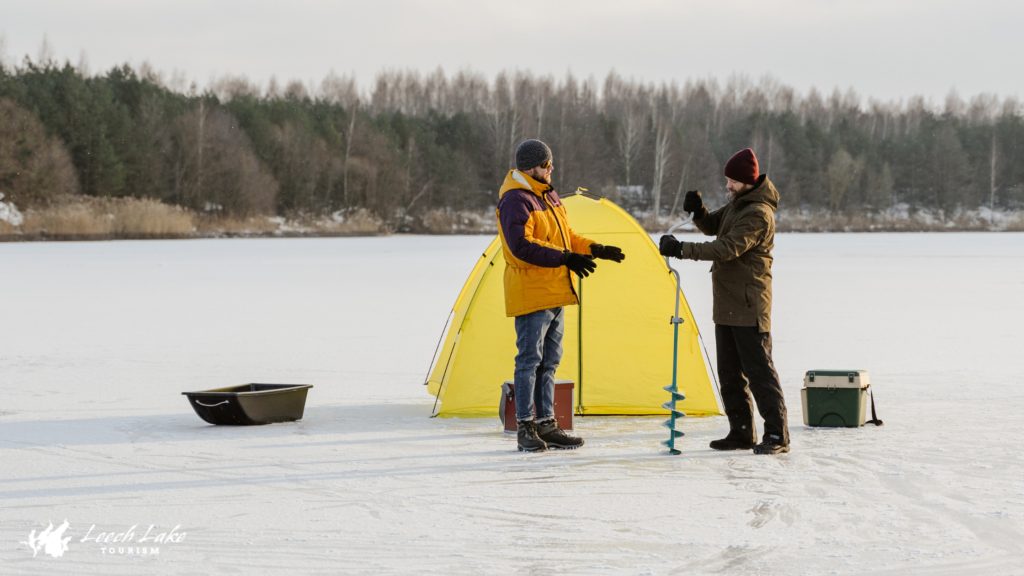Staying Safe on Leech Lake in Winter: Ice Conditions & Safety Tips
February 7, 2025

Winter on Leech Lake is a beautiful time to enjoy ice fishing and other favorite winter activities. The snow-covered lake and peaceful surroundings create the perfect setting for outdoor fun. However, winter on the lake also comes with its own set of risks. If you’re not aware of the ice conditions or the weather, what seems like a perfect day on the ice can quickly turn dangerous. Being prepared and knowing what to look for is key to staying safe while enjoying all that Leech Lake has to offer during the winter months.
1. Understanding Ice Thickness: How Thick is Safe?
The first and most important rule for any lake is understanding ice thickness. Never assume the ice is safe just because it looks solid. Ice conditions can vary greatly depending on weather conditions, the time of year, and specific areas of the lake.
Here are some general ice thickness guidelines:
- 2 inches or less: Unsafe for any activity.
- 4 inches: Safe for ice fishing or walking.
- 5–7 inches: Safe for snowmobiles and ATVs.
- 8–12 inches: Safe for light vehicles like cars or trucks.
- 12+ inches: Safe for larger vehicles like trucks and larger equipment.
Remember, ice thickness can vary from one part of the lake to another. Always check with local authorities, fishing guides, or residents for the most up-to-date conditions before heading out.
2. Check Ice Conditions Regularly
Ice is constantly changing. Even if the ice was thick and solid when you went out, it could weaken due to warming temperatures, sunlight, or shifting winds. Make sure to check the ice regularly as you travel. If you’re unsure, never venture onto the ice without checking its condition first.
Some ways to check the ice include:
- Drilling test holes: Carry an auger or ice drill to test the thickness in multiple areas.
- Observe others: If you see others enjoying the lake, ask about their experiences or where they are fishing. Be cautious, but don’t be afraid to ask for local advice.
- Look for visible cracks: Avoid areas with visible cracks or areas where the ice has shifted, as this can be a sign of weak spots.
3. Traveling on the Ice: How to Stay Safe
While walking, snowmobiling, and ice fishing are popular winter activities, it’s essential to approach travel on the ice with caution.
- Walk Carefully: Always walk slowly and carefully when traveling across the ice. Avoid sudden movements or heavy jumps, as this can create pressure that might crack the ice.
- Use Safety Equipment: Consider wearing a personal flotation device (PFD) under your clothing. If you fall through the ice, the PFD will help you stay afloat and may save your life. Ice picks, which help pull yourself up if you fall, are also a useful tool to carry.
- Stay with Others: If you’re walking, ice fishing, or snowmobiling, always stay with a buddy. If something goes wrong, you’ll have someone to help.
- Avoid Pressure Ridges: Pressure ridges are areas where the ice has shifted or cracked due to movement beneath the surface. These can be dangerous, as they might be unstable, and they can be difficult to spot until you’re too close.
4. How to Stay Safe During Winter Activities
When enjoying winter activities on Leech Lake, safety is key. Follow these tips for a safer experience:
- Carry a Safety Kit: Always have a safety kit with essential supplies. This should include a first aid kit, extra warm clothes, a flashlight, a whistle, and a phone in a waterproof case in case of emergency.
- Know the Weather Forecast: Sudden changes in weather can impact ice safety. A warm day followed by a cold night can create unpredictable ice conditions. Always check the weather forecast before heading out and plan accordingly.
- Avoid Overcrowding: Avoid heavy concentrations of people or vehicles in one area. More weight on the ice increases the risk of breaking through. Stick to well-traveled paths and areas known for thicker ice.
- Watch for Signs of Weak Ice: If you hear cracking or see water on the surface, immediately return to shore and avoid that area. Even a small crack or hole can become a dangerous weak spot.
- Keep an Eye on Kids and Pets: If you’re bringing children or pets onto the ice, make sure they understand the risks and stay close to you at all times. Pets should always be on a leash.
5. What to Do If You Fall Through the Ice
Even with the best precautions, accidents can still happen. If you fall through the ice, remember these steps:
- Stay Calm: Panic will only make the situation worse. Take deep breaths and focus on keeping your head above water.
- Keep Your Body Horizontal: Try to keep your body as flat as possible to distribute your weight and prevent further sinking.
- Pull Yourself Up: Use ice picks or your elbows to pull yourself up onto the ice. Kick your legs and move slowly to avoid breaking the ice further.
- Get Out of the Water Quickly: Once you’re on the ice, move away from the hole quickly to reduce the risk of falling through again.
- Seek Help: If you can’t get out on your own, shout for help. Call emergency services if necessary.
Given Minnesota’s unpredictable winter weather, it’s essential to approach lake activities with caution. By following these safety tips, regularly checking ice thickness, and being prepared for emergencies, you can enjoy a fun and safe ice fishing adventure on Leech Lake!
Feel free to contact the Leech Lake Tourism Bureau with any questions you have and don’t forget to check out the latest fishing report!

